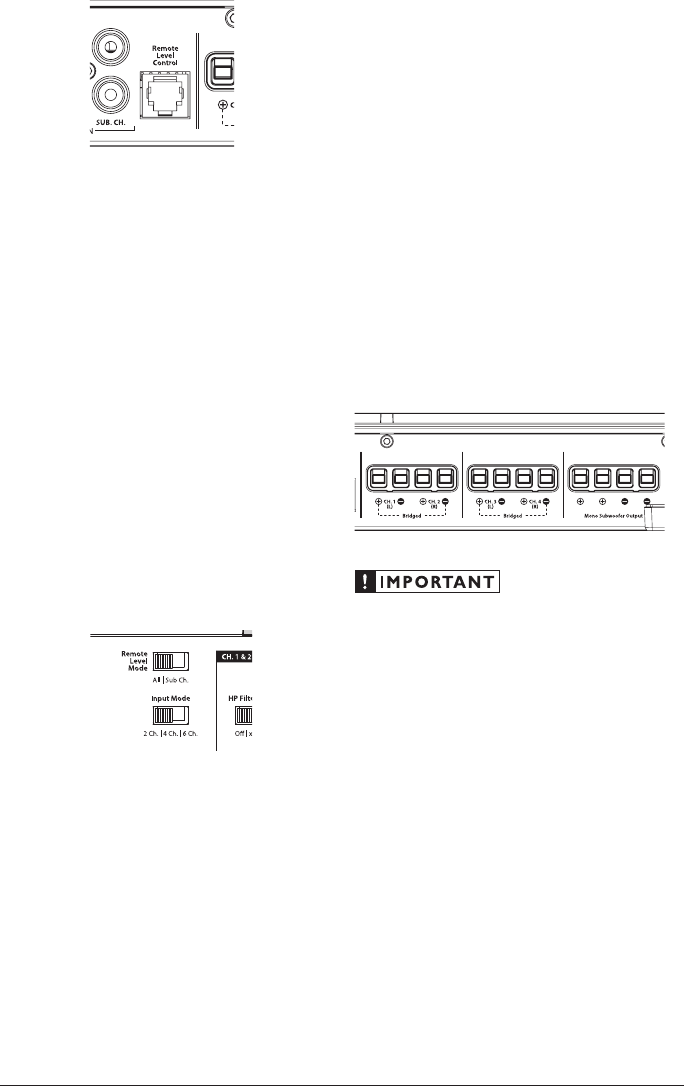
9
REMOTE LEVEL CONTROL OPTIONAL
With the addition of the optional Remote
Level Control (HD-RLC), you can control the
volume of the subwoofer channel (Subwoofer
Level) or of the entire XD700/5 from the front of
the vehicle (Master Volume).
The HD-RLC connects to the jack labeled
“Remote Level Control” on the Connection Panel
of the amplifier using a standard telephone cable
(supplied with the HD-RLC). If desired, multiple
XD (and HD) amplifiers can be controlled from
a single HD-RLC controller using a simple phone
line “splitter” and multiple phone cables.
When connected to the amplifier, the
HD-RLC operates as follows. At full counter-
clockwise rotation, the audio of the selected
channels will mute completely. At full clockwise
rotation the level will be the same as if the
HD-RLC was not connected at all. In other
words, it operates strictly as a level attenuator.
“Remote Level Mode” Switch: This switch
allows you to assign the operation of the
HD-RLC to the entire amplifier or only the
subwoofer channel. In the “All” position, the
HD-RLC knob will affect all channels equally.
In the “Sub Ch.” position, only the level of
the subwoofer channel will be affected by the
HD-RLC knob.
SPEAKER OUTPUTS
The XD700/5’s speaker outputs are designed
to accept 16 AWG - 8 AWG wire. To connect the
speaker wires to the amplifier, first back out the
set screws on the top of the terminal block, using
the supplied 2.5 mm hex wrench. Strip 1/2 inch
(12 mm) of insulation from the end of each wire
and insert the bare wire into the terminal block,
seating it firmly so that no bare wire is exposed.
While holding the wire in place, tighten the set
screw firmly, taking care not to strip the head of
the screw.
Each pair of the XD700/5’s main channels are
designed to deliver power into speaker loads equal
to or greater than 2 ohms when using a “stereo”
configuration and speaker loads equal to or greater
than 4 ohms when using a “bridged” configuration.
The subwoofer channel is designed to deliver power
into subwoofer loads equal to or greater than 2 ohms.
Speaker loads below 2 ohms nominal per
channel (or 4 ohms bridged) are not
recommended and may cause the amplifier
to initiate a protection mode which reduces
power output.
BRIDGING CONSIDERATIONS
Bridging is the practice of combining the
output of two amplifier channels to drive a single
load. When bridged, each channel produces
signals of equal magnitude, but opposite polarity.
The combined output of the two channels
provides twice the output voltage available from
a single channel. The XD700/5 has been designed
for bridging of its main channel pairs without the
need for input inversion adaptors.
To bridge a pair of main channels, use the
“Left +” and “Right –” speaker connectors only
(the “Left –” and “Right +” remain unused). Each
bridged channel pair will deliver optimum power
into a 4 ohm load.


















